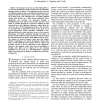67 search results - page 1 / 14 » Evolving morphology and control: A distributed approach |
CEC
2009
IEEE
13 years 11 months ago
2009
IEEE
—In this paper we present a model which allows to co-evolve the morphology and the control system of realistically simulated robots (creatures). The method proposed is based on a...
GECCO
2007
Springer
13 years 10 months ago
2007
Springer
Thirteen years have passed since Karl Sims published his work on evolving virtual creatures. Since then, several novel approaches to neural network evolution and genetic algorithm...
ALIFE
2010
13 years 3 months ago
2010
Embodied artificial intelligence argues that the body and brain play equally important roles in the generation of adaptive behavior. An increasingly common approach therefore is to...
CONNECTION
2004
13 years 4 months ago
2004
The Artificial Life approach to Evolutionary Robotics is used as a fundamental framework for the development of a modular neural control of autonomous mobile robots. The applied e...
GECCO
2009
Springer
13 years 10 months ago
2009
Springer
Problems such as the design of distributed controllers are characterized by modularity and symmetry. However, the symmetries useful for solving them are often difficult to determ...

